
Argentina Home
History
Explorations
Calendar of Events
Travel Tips
Buenos Aires
Cordoba
Mar del Plata
Latin America
The World
Exploring
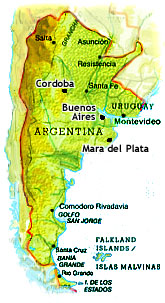 Patagonia Region
Patagonia Region
This vast region south of Buenos Aires begins
at the Rio Colorado and stretches to the Straits of Magellan. It encompasses
interior mountains and glaciers in the
provinces of Rio Negro and Neuquen; sandy beaches on its Atlantic coast,
and forests of beechwood and monkey puzzle trees where it meets the Andes.
The beauty of Patagonia has been preserved in several national parks.
Neuquen
This provincial capital, 265 meters above sea level, sits at the point where
the Limay and Neuquen rivers converge. It has a population of 300,000 and
is the agriculture service
centre for the Rio Negro valley.
Peninsula Valdes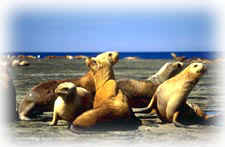
Peninsula Valdes is home to large numbers of sea lions, elephant seals, guanacos,
rheas, Magellanic penguins and numerous other sea birds. Whale sightings
are best in August but
have also been reported through December. Sheep ranches occupy much of the
interior section.
Ushuaia
Few relics remain testifying to life at this former missionary base and subsequent
Argentinean prison. It became a key military base in 1950 and is now a major
vacation destination. Forestry and fishing are the chief occupations of its
inhabitants.
National Parks
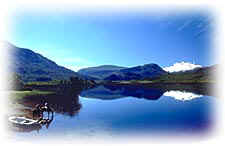 Parque Nacional Nahuel Huapi:
Parque Nacional Nahuel Huapi:The main feature of the park is Lago Nahuel Huapi, a 100 km long lake formed by the Pleistocene glaciers, possessing a single narrow island at its centre. Isla Victoria as it is now known, is notable for its rare species of trees and for a number of exotic animals, including the pudu and the huemul, both rare indigenous deer. The lake is home to a number of native fish species, plus several newcomers such as trout and salmon, offering exceptional sport fishing. However, the real attraction of this region is excellent high country trekking, among its rugged mountains and alpine meadows. Just west of the lake is Tronador -meaning thunderer-, a 3554-metre/11722-foot extinct volcano, and the Chilean border. The area is noted for its forest-covered mountain slopes and the summer blanket of wildflowers.
Parque Nacional Laguna Blanca:
Laguna
Blanca is located 30 km from Zapala in a barren volcanic area of Neuquen. The
shallow lake was formed when lava flows dammed two small streams. One of
only two swan sanctuaries in the western hemisphere, it is a breeding ground
for the distinctive black-
necked swan. Laguna Blanca also features other bird species, such as coots,
grebes, upland geese, gulls, and flamingos.
Parque Nacional Lanin:
This tranquil forest area
extends 150 km north from Nahuel Huapi to Lago Norquinco, with snow-
capped, 776-metre/ 12615-foot Volcan Lanin as its centerpiece. Its flora
includes huge stands of
broadleaf deciduous southern beech, rauli, and pehuen (monkey puzzle tree),
plus lenga, nire, and coihue, which are characteristic of more southerly
forests. Many finger-shaped
lakes attest to the passage of glaciers.
Reserva Provincial Punta Tombo:
Between September and April, half a million Magellanic penguins breed at Punta Tombo,
110 km south of Trelew. Also known as the jackass penguin, these birds exhibit
a distressing tendency to emit loud, donkey- like brays. Given that penguins
cover the
entire visible landscape, the chorus can be quite an experience. Step carefully,
as these breeding birds have a strict concept of personal space and the beak
to back it up. Other
prevalent bird species include cormorants, giant petrels, kelp gulls, flightless
steamer ducks, and oystercatchers.
Parque Nacional Los Alerces:
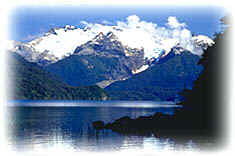 The park was built to protect extensive groves of alerce a large
and ancient conifers that can exceed 150 feet in height and 12 feet in diameter. Alerces
well over two millenia in age grow amongst stands of cypress and incense cedar. The park
is located west of Esquel and also features pristine lakes and streams, enchanting views
and excellent fishing. The area is usually mild in the summer although it can be quite wet
at other times.
The park was built to protect extensive groves of alerce a large
and ancient conifers that can exceed 150 feet in height and 12 feet in diameter. Alerces
well over two millenia in age grow amongst stands of cypress and incense cedar. The park
is located west of Esquel and also features pristine lakes and streams, enchanting views
and excellent fishing. The area is usually mild in the summer although it can be quite wet
at other times.
Parque Nacional Los Glaciares:
Home to almost four dozen major
glaciers, this 2300 square mile/ 6000 square kilometer park is a unique opportunity
to see some of the most powerful forces of nature. The northern section
of the park is characterized by its steep jagged peaks, including Cerro
Fitzroy which exceeds 11000 feet.
This section of the park is particularly popular among trekkers and mountaineers.
It is known as an exceptionally challenging and dangerous climbing area.
The southern section of
the park is more hospitable to casual sightseeing and containe many interesting
glaciers. Moreno Glacier, one of the world's few remaining advancing glaciers
is the most
spectacular, currently grinding its way down the Cordillera directly into
an arm of the enormous Lago Argentino. About every three years the glacier
cuts off the flow of water
into the lake resulting in an immense accumulation of pressure as the water
behind the glacier rises. The explosive resolution of these forces is a
spectacular event to those
lucky enough to witness it.
Monumento Natural Bosques Petrificados:
During
Jurassic times, the extensive forests that once covered this part of Patagonia were buried
by volcanic ash. Subsequent erosion revealed mineralised trees measuring three metres in
diameter and 35 meters / 90 feet in length--some of which remarkably remain standing.
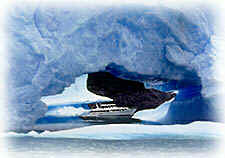 Parque Nacional Perito
Parque Nacional Perito
Moreno:
This jewel of a park is often overlooked by visitors to the area.
Here, glacier- covered mountains rise majestically above blue lakes where
migrant birds sojourn and herds of guanacos lazily feed. The weather here
is often windy and cold, even
in summer.
Copyright (c) 1998-2012 interKnowledge Corp. All rights reserved.
